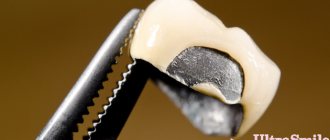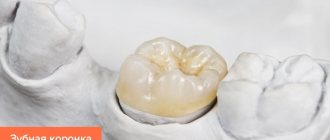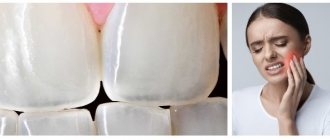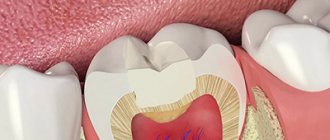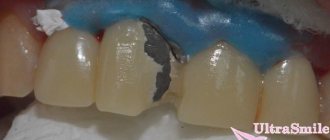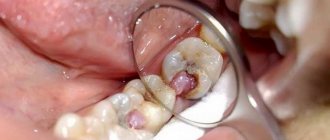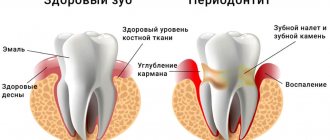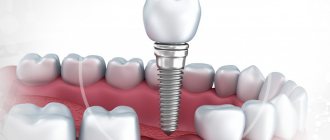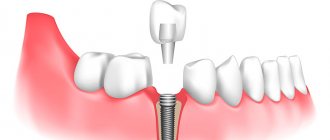June 15, 2019
Many patients are interested in the question of how to remove a crown from a tooth, because essentially the structure is permanent. However, this just means that the owner himself cannot remove it from the mouth, but the dentist, using tools and specialized equipment, will do this without difficulty. Today you will learn about how this process goes, by what methods the final result is achieved, what nuances await patients during the procedure of removing a crown from a tooth from an article prepared by journalists from the editorial office of the UltraSmile.ru portal.
What are the ways to remove a crown?
When is it necessary to remove a crown from a tooth?
Removing the crown from a tooth needs to be done only when there is a serious need for it, because the crown itself can be used for 7-10 years or more (the time period depends on the material from which the prosthesis was made).
Let us list the reasons why it is necessary to resort to such manipulation:
- a disease has developed under the structure: for example, secondary caries, periodontitis or a cyst,
- errors made at one of the stages of prosthetics: perhaps the crown does not correspond to the individual characteristics of the patient, is poorly installed and adjusted, is made of low-quality materials,
- the patient’s desire to replace the structure with a prosthesis made of a better and more beautiful material: for example, replace a metal or metal-plastic product with metal ceramics or zirconium dioxide,
- injuries that led to damage and breakage of an artificial tooth,
- destruction of permanent cement on which the orthopedic structure was fixed,
- The product has expired.
The reason for removal may be the development of caries under the crown.
If the tooth under the crown hurts, there is a bad smell, and the structure has become shaky and movable, then it is time to visit a dentist, who, based on an examination and x-ray, will decide on the need to remove and replace the artificial material.
According to numerous studies, the need to prematurely remove crowns already in the first years of use in 40% of all cases arises due to the fact that poor-quality endodontic treatment and poor-quality sanitation of the oral cavity were performed before preparing for prosthetics.
All of the above reasons are a serious reason to think about removing the prosthetic structure. Naturally, first you need to go to an appointment with a dentist, who will explain how crowns are removed from teeth. And we will look at the methods that exist today.
Manufacturing process
Let's look at how metal-ceramic bridges are made in stages:
- Examination of the oral cavity and treatment of detected diseases (for example, caries).
- Grinding the teeth on which the bridge will be attached.
- Coating of supporting teeth with a special protective varnish.
- Taking an impression.
- Installation of temporary crowns on abutment teeth in order to protect them from external influences.
- Gum retraction.
- Next, a model of the future design is made and placed in the occluder.
- A wax frame is made for the metal structure.
- A gating system is made.
- The molding compound is prepared, the metal is melted and the frame of the bridge is made.
- The metal frame is prepared for processing with ceramics.
- A ceramic layer is applied and fired.
- The finished product is tried on and adjusted in the patient’s mouth.
- The bridge is installed by attaching it to the supporting teeth.
In order to make a prosthesis from metal-ceramics, coordinated work of the dental technician and the dentist himself is important. The latter must thoroughly prepare the oral cavity and supporting teeth for installing the prosthesis, take impressions to create the product, and select the shade of ceramics. The task of the dental technician is to produce a design that best suits all the characteristics provided by the dentist.
Method No. 1: sawing with a boron
So, let's figure out whether it is possible to remove a crown with permanent cement.
The method of removal using boron is the oldest and by far the most unaesthetic. This means that after using this tool, the sawn artificial material will only have to be thrown into the trash bin, because it can no longer be used for its intended purpose, that is, it will no longer be possible to re-prosthetize a tooth with it.
The technique is simple, cheap and quite effective, but it must be used by a doctor who has a high level of professionalism, because the approach requires caution and precision. An inexperienced specialist may damage the tooth itself or the soft tissue around it during the dismantling process.
With this method, it will not be possible to reuse the crown
“We removed the crown from the tooth with a regular bur and simply sawed it in half. There’s nothing terrible, but when the material got very hot, the smell, I’ll tell you, was not very good, plus there were slightly painful and uncomfortable sensations, even despite the fact that I had been given anesthesia before this, and the tooth itself had been under the prosthesis for a long time depulped!"
Mari, review from 32top.ru
This method is used if the patient has dentures made of inexpensive materials, which he would not mind disposing of later. The method is also suitable if the artificial structure itself is mobile or wobbly. Then it is simply sawed to the teeth, then, using special tools, the resulting edges are carefully bent in different directions and removed.
After the procedure
P¾ÃÂûõ ÃÂýÃÂÃÂøàÿûþüñàòÃÂðÃÂ, õÃÂûø øüõÃÂÃÂÃÂàÃÂþþÃÂòõÃÂÃÂÃÂòÃÂÃÂÃÂøõ ÿþà úð÷ðýøÃÂ, ÿÃÂþòþôøàûõÃÂõýø õ ÷ÃÂñð. ÃÂý ÃÂôðûÃÂõàþÃÂüõÃÂÃÂøõ ÃÂúðýø, àÃÂÃÂÃÂðýÃÂõàòþÃÂÿðûõýøõ ø òÃÂÿþà ýÃÂõàøýÃÂõ üõÃÂþÿÃÂøÃÂÃÂøÃÂ. ÃÂþ þúþýÃÂðýøø ûõÃÂõýøàÿÃÂþò þôøÃÂÃÂûþüñøÃÂþòúð ÿþûþÃÂàø ø ÿþòÃÂþÃÂýþ ÃÂÃÂÃÂðýðòûøòð õÃÂÃÂàúþÃÂþýúð.
ÃÂÃÂûø ÿÃÂþÃÂõôÃÂÃÂð ñÃÂûð ýð÷ýðÃÂõ ýð ø÷-÷ð ýõôþÃÂÃÂðÃÂþÃÂýþù ÃÂøúàðÃÂøø üðÃÂõÃÂø ðûð, ÃÂþ ÃÂÃÂþüðÃÂþûþó ÃÂôðûÃÂõàò õÃÂàÃÂõüõýàø þñÃÂðñðÃÂÃÂòðõàþñ ûðÃÂÃÂàðýÃÂøÃÂõÿÃÂø úþü. ðÃÂõü ÿÃÂþÃÂõ÷ ÃÂÃÂÃÂðýðòûøòðõà ÃÂÂàýð ÿÃÂõöýõõ üõÃÂÃÂþ.
ÃÂýõ ÷ðòøÃÂøüþÃÂÃÂø þàÿþúð÷ðà ÿÃÂþòõôõýøàÿÃÂþÃÂõôÃÂÃÂàÿõÃÂõô õõ ýðÃÂðûþü òÃÂð þÃÂÃÂðòûÃÂõàÿðÃÂøõýÃÂð ýð ÃÂõýà óõý ÃÂþÃÂþòþù ÿþûþÃÂÃÂø. The › ¸ÃÂõÃÂúøàø òþÿðÔ › àÃÂúðýÃÂÃÂ, ð ÃÂðúöõ úðÃÂõÃÂÃÂòþ ÿÃȈ › ò.
ÃÂð þÃÂýþòðýøø ôðýýÃÂÃÂ, ÿþûÃÂÃÂà õýýÃÂàò ÃÂþôõ ôøðóýþÃÂÃÂøúø, ÿà VALUE úþÃÂþýúø ø, õÃÂûø øüõÃÂÃÂÃÂàÃÂþþ ÃÂòõÃÂÃÂÃÂòÃÂÃÂÃÂøõ ÿþúð÷ðýøÃÂ, ÃÂÃÂÃµà › ûþóøø.
ÃÂðöýþ þÃÂüõÃÂøÃÂÃÂ, ÃÂÃÂþ òÃÂÿþûýà› ýõ ÃÂõúþüõýôÃÂõÃÂÃÂÃÂ. ÃÂþ-ÿõÃÂòÃÂÃÂ, ÃÂôðûøÃÂàúþýÃÂÃÂÃÂÃÂúàøààÿþòõÃÂÃÂýþÃÂÃÂø ÷ÃÂñð ÿÃÂðúÃÂø ÃÂõúø ýõòþ÷üþöýþ ÿÃÂø ÃÂÃÂÃ»Ã¾à ²Ã¸ ø, õÃÂûø þýð ýõ ÃÂðÃÂðõÃÂÃÂÃÂ. ÃÂþ-òÃÂþÃÂÃÂÃÂ, ÿÃÂþÃÂõôÃÂÃÂð ÿÃÂõôÃÂÃÂò The VALUE.
ÃÂÃÂþüõ ÃÂþóþ, øÃÂúÃÂÃÂÃÂÃÂòõýýðàú The ÿÃÂø ÿþòÃÂõöôõýøø úþàþÃÂþù ÿþÃÂÃÂõñÃÂõÃÂÃÂàýðÃÂðÃÂà¸Ã²Ã°Ã½Ã¸Ãµ üÃÂóúøàÃÂúðýõù àÃÂõûààýðôõöýþù ÃÂøúÃÂðÃÂøø Ã¸Ã¼Ã¿Ã»Ã°à ½ÃÂð.
áýÃÂÃÂøõ úþÃÂþýúø à÷ÃÂñð ÿÃÂþøà VALUE ¸Ã½: øÃÂÃÂõú ÃÂÃÂþú ÃÂûÃÂöñàÿÃÂþÃÂõ÷ð, ýõôþÃÂÃÂðÃÂþÃÂýðàÃÂøúà ðÃÂøàüðÃÂõÃÂøðûð ø ôÃÂÃÂóþõ. ãôðûõýøõ úþýÃÂÃÂúÃÂúÃÂøø þÃÂÃÂÃÂà ÃÂÃÂòûÃÂõÃÂÃÂàÃÂþûÃÂúþ ò ÃÂÃÂþüðÃÂþû þóøÃÂõÃÂúþù úûøýøúõ. àþÿÃÂõôõûõýýÃÂàÃÂøÃÂÃÂðÃÂøÃÂàýà° ÷ÃÂñ ÃÂÃÂÃÂðýðòûøòðõÃÂÃÂàÃÂð öõ úà¾ÃÂþýúð.
Method No. 2: using ultrasound
Are you wondering how to remove a crown from permanent cement in one of the safest and most innovative ways, and without causing any damage to it? Then ask your dentist if it is possible to use ultrasound in your case. Through impulses, the doctor acts on the cement composition, which gradually cracks. The specialist moves along the “tooth-crown” boundary; under the influence of vibrations, the cement is destroyed.
The product can be removed using ultrasound
The procedure really allows you to remove the structure in its original form, but it has a number of disadvantages. First, ultrasound has a rather gentle effect, so it is not always possible to achieve the goal the first time, and sometimes you have to visit the doctor several times. Secondly, only products that are made from not very dense materials are amenable to hardware exposure to sound waves. For example, it will not be possible to remove structures made using glass ionomers using ultrasound. Third, vibrations may be unpleasant for the patient.
Select the required service
The procedure is indicated in the following cases:
- It is necessary to restore the crown part of the tooth when it is destroyed by more than 60 percent.
- An unaesthetic appearance, a dental anomaly that cannot be corrected with braces.
- Thinned enamel.
- A bridge prosthesis needs to be installed (crowns are placed on adjacent teeth).
- Fluorosis.
- Chipped tooth due to injury.
Installing a crown will protect the tooth from further destruction or fracture at the gum level. It is possible that an implant will be required before the procedure. This is necessary if the root of a tooth is lost, several teeth are lost in a row, or a row is not formed.
Method No. 4: Kop (Koch) apparatus
This is a tool that again has a hook at the end. However, the device is not launched mechanically, but using a button, which breaks the cement along the edge of the crown using small shocks or a shock wave, after which the structure begins to move from its place. Next, the doctor can only use special forceps that hook and help to finally remove the prosthesis.
See what the Koch apparatus for removing crowns looks like in the photo.
This is what the Koch apparatus for removing crowns looks like
This device is more convenient and efficient than a manual device; it allows you to remove the product with virtually no damage and “works” quickly. However, it also has disadvantages. In particular, many patients note that during the procedures they feel “twitching” and discomfort. Also, some people are very concerned about the noise that the device makes. There is one more drawback - the device can damage the ceramic coating of the crown, leaving chips and cracks, and then the structure will have to be restored.
Method No. 5: using the Coronaflex device
The device looks like a pistol, and its operating principle is based on compressed air, which escapes from the device under pressure and breaks the cement. At the same time, this device does not have any negative effect on the artificial material of the structure or on the soft tissues of the patient.
The Coronaflex device is not available in every dentist today, so the procedure with it will be more expensive compared to other methods. However, it makes sense to use the device if you have a zirconium dioxide crown, which can be reinstalled after, for example, the tooth under the structure is cured. In addition, the procedure using this device is more comfortable, safer, and requires less time to solve the problem. Also, according to patient reviews, the device makes virtually no noise, which allows you to feel comfortable in the dentist’s chair.
The Coronaflex device removes the crown quite comfortably
Preliminary consultation and treatment planning
After the patient and specialist determine the type of prosthesis that will be installed, they begin to select the material used for its manufacture.
The most common and popular are metal-ceramic prostheses. You can also make a prosthesis from metal, porcelain or gold. Zirconium ceramics and aluminum oxide are also popular and very durable.
Let's look at the stages of installing dental bridges:
- Examination of teeth and jaw.
- If necessary, treatment of teeth and gums is performed.
- Introduction of anesthesia.
- Preparation of supporting teeth (most often grinding them).
- Casts and x-rays of the opposite row of teeth, as well as supporting teeth.
- Making a model of a prosthesis from plaster and trying it on.
- Choice of crown color. At this stage it is excellent to work with ceramics, since this material allows you to choose the most suitable shade of color.
- Creating a temporary bridge that will protect the teeth from external irritants before making a permanent one.
- Making a permanent bridge.
- Installation and cementation of the prosthesis.
Is it possible to remove a crown at home?
If you are interested in the question of how to remove a crown from a tooth at home, then the answer will be clear: you cannot do this at home. This procedure should only be performed by a professional dentist. For those who neglect this rule, everything can end sadly: there is a risk of damaging not only the artificial material, but also injuring the soft tissues and the tooth itself, which is located under the crown.
You can try to remove the structure yourself only if it has come unstuck and started to loosen, or if it has fallen apart or split, and there is a need to remove the remaining fragments of the product, which can injure the mucous membrane or antagonist teeth. But it’s better if you rush to see a dentist even in such situations.
If the structure comes unstuck, you can remove it yourself
If the materials from which the crown was created, as well as the cement, have expired, and you do not rush to the dentist, then an unpleasant situation may await you. For example, artificial material can be swallowed. What to do in such situations, read the material “5 useful tips for those who have swallowed a crown.”
Is it possible to cure a tooth without removing the crown?
The question is very relevant, because usually, after removing a structure, it can rarely be reused for its intended purpose, therefore, you have to pay money for the manufacture and installation of a new prosthesis. Fortunately, today in some cases you can do without removing the structure. For example, if it is necessary to cure recurrent caries or remove a small cyst, the doctor may perform endodontic manipulations through a small hole made in the crown or through an incision in the gum (to remove the cyst). After the procedures, this hole will be masked with a composite material, and the sutured gum will need time to heal.
In some cases, modern technologies make it possible to cure a tooth without removing the crown.
However, you need to understand that in order to safely and effectively carry out such jewelry manipulations, the doctor must be a professional. In addition, the patient himself should seek help when the problem is still minor and the inflammatory process has not gone too far. To do this, it is necessary to undergo preventive examinations, because the more minor the problem, the easier it is to solve it with therapeutic methods, without resorting to drastic measures.
Notice
: Undefined variable: post_id in
/home/c/ch75405/public_html/wp-content/themes/UltraSmile/single-item.php
on line
45 Notice
: Undefined variable: full in
/home/c/ch75405/public_html/wp-content /themes/UltraSmile/single-item.php
on line
46
Rate this article:
( 6 ratings, average: 5.00 out of 5)
crown
- Lutskaya I.K., Zinovenko O.G. Frequency of development of caries in teeth covered with artificial crowns.
Following actions
After removal of the orthopedic product, the patient may experience discomfort and pain.
To identify the cause of pain, a specialist examines the condition of the tooth. In some cases, radiography is performed for an accurate diagnosis.
The doctor’s algorithm for further actions will depend on the situation as a result of which the crown had to be removed:
Treatment of the inflammatory process. In the presence of diseases such as pulpitis, caries and periodontitis, the root canals of the tooth are unfilled. Next, the doctor’s task is to prevent the pathological process in tissues using anti-inflammatory therapy. At the last stage of treatment, a filling is installed.
Restoration. To prevent subsequent destruction of the crown if it is damaged or chipped, restoration measures are required.
Replacement of cement when it is destroyed
Here it is important to quickly treat the stump with antiseptic agents and re-fix the prosthesis using new dental cement.
Replacement of the structure at the request of the patient or if it is impossible to reuse it. Using an x-ray, the doctor evaluates the quality of dental canal filling, as well as the condition of the periodontal structures.
After this, you can select and order a new design.
The therapeutic course of treatment includes the following procedures:
- to fight infection and eliminate inflammation, the patient is prescribed medications from the group of antibiotics;
- Rinsing the mouth with decoctions of medicinal herbs and Furacilin solution is effective;
- To reduce pain, dentists recommend using anti-inflammatory compresses with an analgesic effect.
A paste made from 1 tablet of Nurofen and a few drops of boiled water has worked well here. It is rubbed into the wound area.
In rare cases, the tissue under the crown becomes permanently damaged and cannot be saved. Under such circumstances, the doctor warns the patient about the extraction of the tooth from the alveolus and the impossibility of re-fixing the crown.
As an alternative, you can choose another prosthetic option or resort to implantation.
Comments
Good afternoon. My metal-ceramic bridge on one tooth became movable. It is possible to remove the bridge without damage in order to reuse it. Thank you.
Svetlana (06/18/2019 at 11:25 am) Reply to comment
- Dear Svetlana! As a rule, no, the bridge is completely removed (you need to saw it). In addition, it is fixed on at least 2 supporting teeth, which apparently have become unusable.
Editorial staff of the portal UltraSmile.ru (06/21/2019 at 12:23 pm) Reply to comment
Tell me, how do you remove the crown from the implant?
AlinaR. (06/22/2019 at 17:29) Reply to comment
- Dear Alina! There are two extraction methods here, and which one to use will depend on how the crown is attached to the implant. If the fixation was screw (which is more preferable), then the doctor will simply unscrew the screws connecting the crown, implant and abutment. If the fixation was cement, then the specialist will use the cutting method - others are not suitable for implantation.
Editorial staff of the portal UltraSmile.ru (06/25/2019 at 09:19) Reply to comment
Which doctor should I go to to have my crown removed?
Makar (06/30/2019 at 10:02 pm) Reply to comment
- Dear Makar! This manipulation should be performed by an orthopedic dentist.
Editorial staff of the portal UltraSmile.ru (07/03/2019 at 09:17) Reply to comment
Is this procedure, removing a crown from a tooth, painful?
Arfa (07/18/2019 at 04:47 pm) Reply to comment
- Good afternoon This procedure cannot be called pleasant and comfortable, but it is painless, because... the doctor applies anesthesia. In addition, in most cases, crowns are used to replace already pulpless teeth that do not have a nerve. Pain and discomfort can only occur if inflammation has begun under the crown. Then pain can be felt not only in the tooth itself, but also in the soft tissues surrounding it.
Editorial staff of the portal UltraSmile.ru (07/26/2019 at 09:33) Reply to comment
Will my tooth hurt after the crown is removed?
Vedeneeva Victoria (05.08.2019 at 19:05) Reply to comment
- Dear Victoria. A tooth can only hurt if it has developed periodontitis or granuloma. Less often, pain occurs because the crown removal procedure was carried out by a not very professional doctor, who could injure the gums or mucous membranes, or damage the tooth itself.
Editorial staff of the portal UltraSmile.ru (08.08.2019 at 09:25) Reply to comment
Tell me, what if the crowns do not fit tightly to the gums on the back side, where is the palate? is this normal? that is, the tricrowns on the right entered the cast gums; three crowns _and the other three on the back side I feel their edges with my tongue….
san (01/09/2021 at 04:13) Reply to comment
a metal-ceramic bridge costs 10 months on one side it moves away and sways I was at the doctor’s appointment and the answer was swing the entire bridge and come what to do
Natalia (09.12.2021 at 18:51) Reply to comment
Write your comment Cancel reply
What is a cermet bridge?
A metal-ceramic bridge is a metal base on which several crowns rest at once. The class of such a prosthesis is non-removable. Thanks to it, you can restore from 1 to 4 teeth. The edges of the bridge are attached to the supporting teeth, and the empty space between them is filled with crowns.
This design has high functionality of artificial teeth and their significant reliability. Such bridges are made by spraying ceramics onto a metal alloy. Metal gives the product strength, and ceramics allows you to make a prosthesis that is as close as possible in color to the shade of enamel on living teeth.
Many dentists recommend their patients to install metal-ceramic bridges because of their high strength, durability, high aesthetics, resistance to dyes and good repairability.
The manufactured material does not cause chemical or allergic reactions, which allows the use of metal-ceramic products for almost every client of the dental clinic.
Let's consider the metals that are used in the manufacture of such products:
- Alloys of cobalt and chromium with base metals.
- Semi-precious, for example - zirconium.
- Precious metals are alloys of gold with palladium or platinum.
An important component for the ability to install a bridge is the presence of two supporting teeth that are able to take on the entire load falling on the bridge. For fastening it is necessary to grind the support teeth
If necessary, they are sometimes sealed or a pin is installed.
Stock
-9%
BASAL COMPLEX - Restoration of teeth on 1 jaw in 3 days 330,000 rub.
300,000 rub.
get -17 %
Quadrotti dentures (without palate) 60,000 rub.
50,000 rub.
get -27 %
Teeth in 1 day on Straumann implants using ProArch technology!
300,000 rub. 220,000 rub.
get -35 %
Metal-ceramic crown 10,000 rub.
6500 rub. get
